Listed 26 sub titles with search on: Places of worship for wider area of: "TRIKALA Prefecture THESSALIA" .
Tel: +30 24320 22752
The
Holy church of "Koimesis", situated North-East of the municipality of Kalambaka,
was the old cathedral of the Bishopric Stagoi.
The church is a spacious basilica with nave which rises higher than
the two aisles. It was built probably in the 10th or 11th century, on the remains
of an early - christian basilica. Part of the floor mosaic is saved, while material
from the early byzantine ambo has been used to firm the new one of marble, in
the centre of the church. From the old church comes the ciborium of marble and
the synthronon. The wall paintings of the church date from 12th to 17th century.
The monument has been restored and the frescoes (part of them;) conserved.
Nowadays it is used as a church.
MONI DOUSSIKOU (Monastery) TRIKALA
In a picturesque location of Koziakas
and in the vicinity of the community of Agios Vissarionas (known as Dousiko) the
Abbey of Agios Vissarionas or Abbey of Dousiko. The church of the abbey was built
in 1545 and was decorated with hagiographies in 1558, by the famous painter of
the Cretan School Georgy. This must have been built in the place of the first
temple, which Agios Vissarionas built, proprietor of the abbey. The abbey was
one of the most wealthy monasteries since it had 366 cells, rich library and many
relics.
This text is cited Oct 2003 from the Municipality of Pyli URL below, which contains images.
PYLI (Small town) TRIKALA
Tel: +30 24340 22420, 23180
The
Holy church of Porta Panagia, was the church of the Monastery of "Great Entrances"
(Megalon Pylon). It lies on the bank of the river "Portaikos" in the north of
"Pylis" Municipality in the community "Porta".
In the Porta-Panagia both centre bay and cross arms are pulled together
by one single transverse barrel vault, high up. The church was built by sebastokrator
John - Angel Duke Komnenos in 1283. The exonarthex belongs to the type of domed
octagon, the iconostasis is decorated with mosaic icons of Christ and Virgin placed
in an inverse position (1283 - 1289). The remained frescoes both in the nave and
the narthex date to 18th century.
Restoration works have been done in the church. While works of fixing
and restoration were taking place in the monastery, excavations on the floor of
the church brought to surface the first floor and plenty architectural parts of
the ancient temple in second use.
Nowadays it is used both as a church and archaeological site to be
visited.
Opposite to Pyli, in the settlement of Porta-Panagia it is the famous
homonymous Byzantine temple, which in the old days constituted the catholic of
the abbey which was under the Patriarch's jurisdiction and carried the name of
the Impregnable Virgin Mary. This was destroyed during the Ottoman domination.
The temple was built in 1283 by Ioannis Aggelos Komninos Doukas, illegitimate
son of the despot of Ipirus Micheal Douka the 2nd.
It is consisted of the main temple and the ulterior (at others previous)
forth-narthex.
The Abbey of the Big Portal that also included the temple of Porta
Panagia, in the Byzantine years was a rich abbey under the Patriarch's jurisdiction
(that is to say depended directly on the Patriarch) with a lot of properties,
which, when the abbey was destroyed in the years of the Ottoman domination, were
given to the residents of the neighbouring Pyli, while the temple with a letter
in 1843, devolved to the property of the
Abbey of Dousikos. The temple of Porta Panagia, is a cross-roofed three-aisle
royal that has been built on an ancient temple. This is testified by the pillars
that are found in the area round the temple, as well as by the existence of many
architectural members either fixture or collected occasionally, that today are
kept in the temple. This temple follows the same architectural type with the temple
of Κato Panagia,
in Arta.
Westwards of the temple, there is a wide forth-narthex that follows
the type of the registered cruciform with dome and is dated in the dues of the
14th century. The temple beyond the bizarre architecture has also to present rich
sculpture, mosaic and written decor that unfortunately were destroyed by the fire
of 1855. From the sculptural decor fragmentarily capitals were saved, which turned
the pillars and part of the marble temple to the Prothesis and the central aisle.
From the mosaic decor were saved - the unique in the Hellenic area so much for
the technique and the style as for their bizarre inverted position - mosaic pictures
of Christ and Virgin Mary.
The professor Anastasios Orlandos places their manufacture in 1285,
hε connects them with the mosaics of the dome of the
abbey of Parigoritjssa in Arta and in particular, he attributes them in the
same craftsman. From the iconographic decor, remarkable is the mural that covers
the semicircular niche, in the SW corner of the main temple, where the proprietor
of the abbey Ioannis Doukas is portrayed that an angel leads him to the protector
of the abbey, Virgin Mary. It is one of the most infrequent portraits of the Komnenians.
The last excavational research brought into light the grave of Ioannis
Doukas - unfortunately despoilt. The same excavational research, which was made
in the context of the LEADER program for the restoration of the abbey, brought
also in the light parts of the initial marble temple, parts of the ancient inscribed
columns, all of which constituting the second flooring of the abbey, of course
in second use. Also the base of the initial stone pulpit came into light and the
marble pillar that supported the High Altar, while segmentally the initial marble
flooring of temple was revealed.
Finally, interesting are also the murals that are saved in the Chancel
which are placed in the 13th century. The mural in the arch of the central declinable,
those next to the window of the southern and the western side of the temple, are
mainly dated in the 18th century just like those of the splint - to which unfortunately
the fire of 1980, incurred irreparable damage.
This text is cited Nov 2003 from the Municipality of Pyli URL below, which contains images.
AGIOS PROKOPIOS (Village) TRIKALA
The Abbey of the Great Martyr Agios Prokopios is found in the village
"Ag. Prokopios" of Trikala, in an altitude of 700m. 10 km far from the
town of Pyli.
It is built on the slopes of the mountain "Stefani", of Pindos'
mountain range, in a splendid location with abundantly spring waters, drowned
in the green, with marvellous forest from a variety of trees and thickets.
The roughly 48 acres of the Abbey were paled with stone wall from
bulky stones that in many places are apparent until today. Round the Temple and
the cells there was a roughly 2 m. high wall and immured an area of roughly 4
acres. It had two entries eastwards and westwards. The Catholic of
the Abbey was stone-built. The roof and the dome were made from flint and in many
places of the roof as well as in the corners of the dome there were fixture special
earthen vessels for the creation of good acoustic of the room. The roof was made
from stone. In the northern part there was a small door of entry with the top
part arched. This door led to the Narthex that was separated from the main Temple
with a stone wall. A small door, smaller than the entry led to the Main Temple.
The Temple was Byzantine, three-aisled, with dancing and dome, entire with hagiographies.
The Temple was wood-curve, of most excellent style. Proportion sculptured decorated
with ivory. The candlesticks from crucible wrought iron.
The earthquake in 1954, lead the top of the dome to collapse and the
walls of the Abbey suffered serious cracks. The non re-establishment of the damages
and the weather contributed, so that the damages become irreparable. So, in 1960
the ignorance... demolished everything that had remained standing, in order for
a new smaller temple to be built.
This effort to construct a New Temple stopped in the foundation up
to 1986. In 19/10/86 with the benedictions of the Venerable Metropolite of Trikki
and Stagon Mr. Alexios, a new foundation of the Temple was laid. After 4 years
of efforts, the New Temple was completed and was inaugurated by the Metropolite
Mr. Alexjos in 8/7/1989. From the church of the Old Abbey 6 pictures of the Temple
were only saved and two Holy Gospels. According to information the Abbey was founded
in the Middle of the 16th century in honour of the Prophet Elias.
Later, unknown how, the Abbey of the Prophet Elias was renamed into
Abbey of Agios Prokopios. The tradition reports that an old monk saw in a vision
' Saint Prokopios saying to him: "The prophet Elias has many Temples all
over Greece, however I have not even one". Then a delegation of monks - always
accordingly to the tradition - returned in the Patriarchate and reported the drama
in the Patriarch. He advised they should build a divine Temple for the praise
of Agios Prokopios. And it may be the only Abbey in the Christian world, for the
praise of the Great Martyr Agios Prokopios. On a marble slate that was found,
the church of the Abbey had been renovated in 1761. Also, according to information
of the villages' residents, up to 1924 the Abbey was functioning, as elders report
the presence of two old monks.
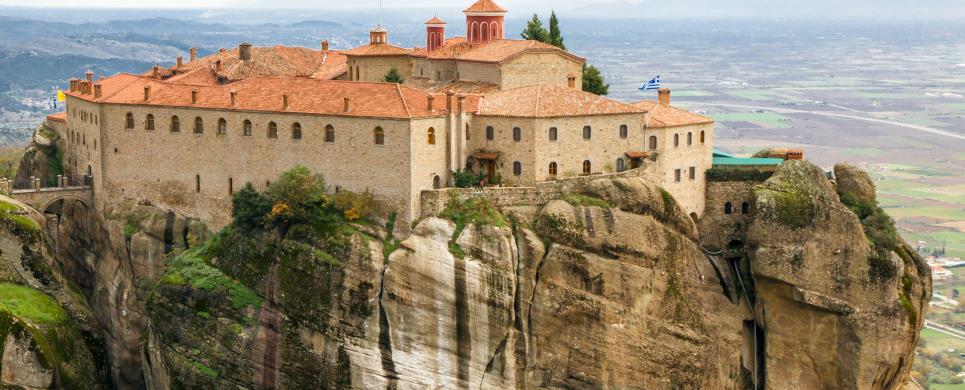
METEORA (Area of exceptional beauty) TRIKALA
Tel: +30 24320 22279
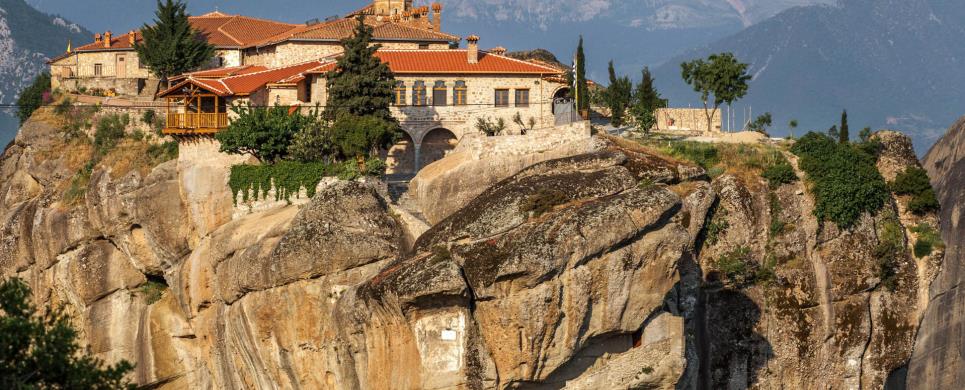
Tel: +30 24320 22220
The Holy Trinity Monastery is an Eastern Orthodox monastery situated at the top of a rocky precipice over 400 metres high and forms part of 24 monasteries which were originally built at Meteora, one of the oldest still existing of the Meteora monasteries. Six of the 24 monasteries are still active and open to visitors.
The church was constructed between the fourteenth and fifteenth centuries and is included in the UNESCO list of World Heritage Sites titled Meteora.
The monastery was featured in the 1981 James Bond film, For Your Eyes Only.
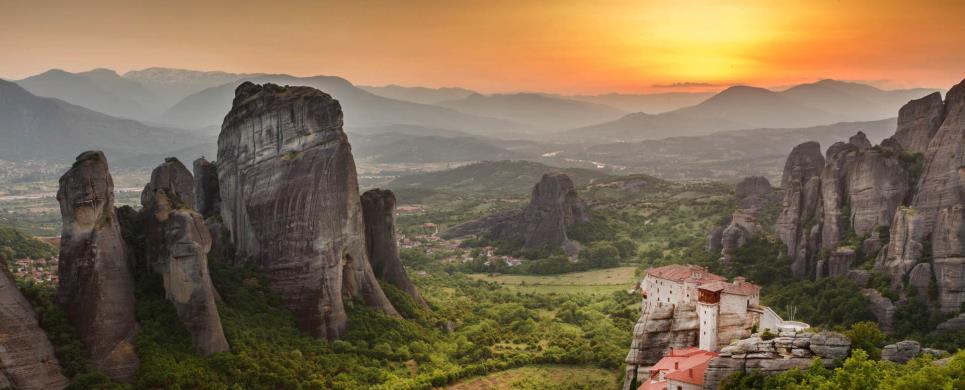
Tel: +30 24320 22649
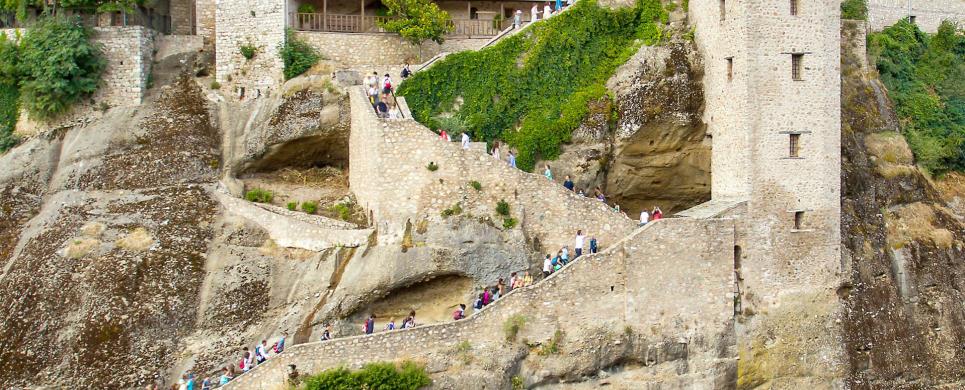
Tel: +30 24320 22278
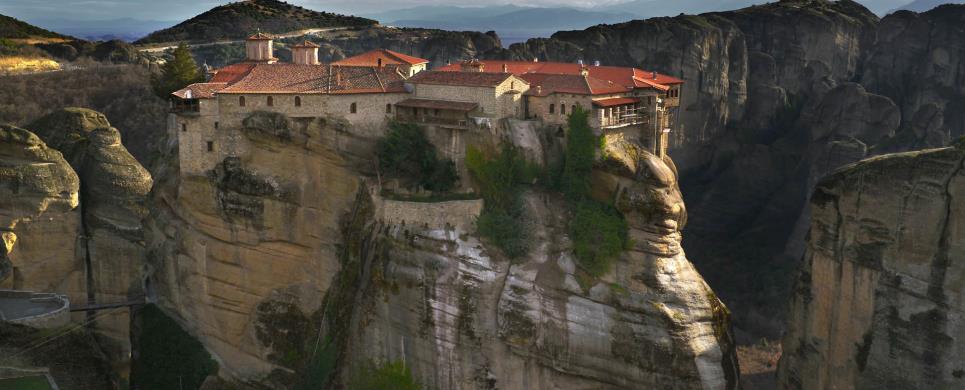
Tel: +30 24320 22277
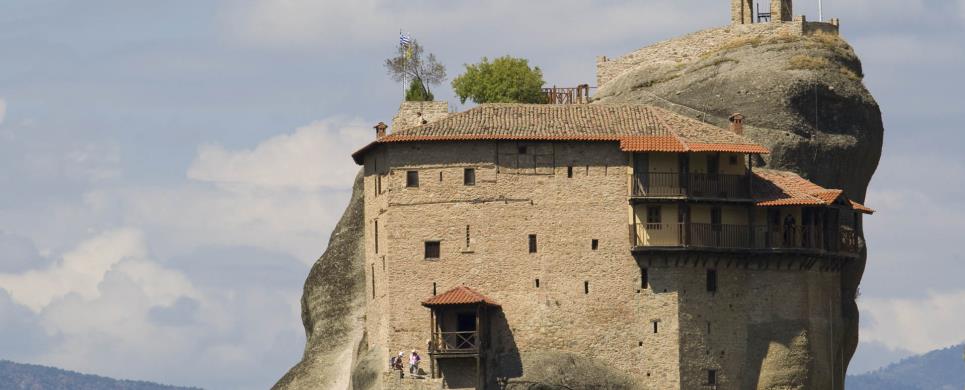
Tel: +30 24320 22375
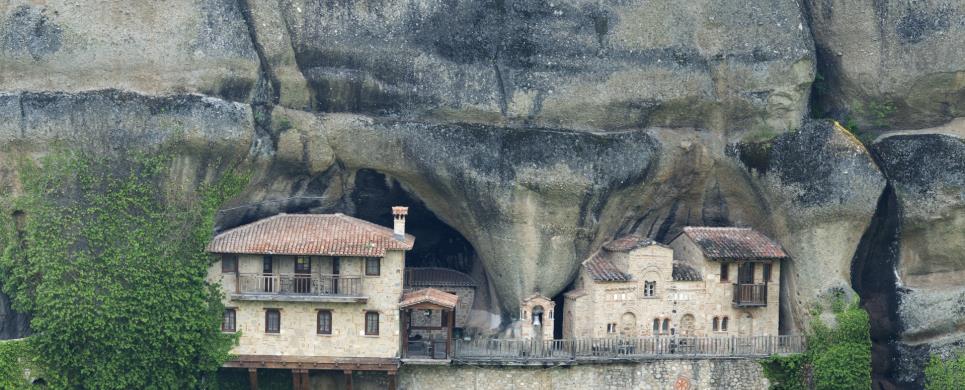
Candlemas monastery is belonged to the Great Meteoron monastery. It is a ruinned monastery, which has been restored partially and is available for visit under some certain conditions.
The monk Neilos, is recorded in relevant documents and inscriptions as the founder of the monastery in the years 1366-7.
MONI DOUSSIKOU (Monastery) TRIKALA
Tel: +30 24340 22420
MONI KOIMISSEOS THEOTOKOU GOURAS (Monastery) TRIKALA
Tel: +30 24340 22423
It is feminine, built above Pyli
on the mountain Itamos and in an altitude of 640 m. The view from the nunnery
is unique. The nunnery was built in 1743.Forayed or burnt time after time (1770,
1823, 1854, 1878, 1943). The look that has today has started to take in 1961.
8/5
At a distance of 2 km.
Receive our daily Newsletter with all the latest updates on the Greek Travel industry.
Subscribe now!